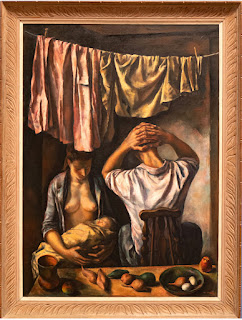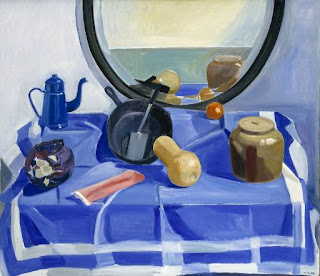Many people are interested in investing in art instead of the stock market. When someone wants to build an art collection as investment, it is important to stress the risks involved. Since the 1800s art dealers have been advising clients to buy the art they love. This is the single, most important element of collecting. If a piece loses its market value after purchase, the buyer still has a personal attachment to it. Buying what you love is the safest way to invest in art.
Building an art collection from a pure investment position creates an entirely different set of issues. Some economists suggest art investment can be more lucrative than the stock market, but the mercurial trends of the art market can make art a riskier asset than stocks.
In 1637 a Dutch event called
tulip mania took place, where prices for rare flower bulbs of the recently discovered tulip reached extraordinary heights and then suddenly collapsed. In the spring of 1637, a single tulip bulb sold for approximately ten times the annual income of a working craftsman. It is generally considered the first recorded economic bubble.
The tulip was unique from other flowers known to Europe in the period, with a saturated petal color unknown to mostly flower collectors. The nonpareil tulip became a status symbol and coincided directly with the rise of new trade fortunes of Holland's elite.
By 1636 the tulip bulb became the fourth leading export product of the Netherlands, after gin, herrings and cheese. The price of tulips skyrocketed because of speculation in tulip futures among people who never saw the bulbs. Many men made and lost fortunes overnight. The collapse began in the town of Haarlem when buyers suddenly did not show up for the routine bulb auction.
In the art market, especially with contemporary art, hedge fund managers like Steven A. Cohen have stimulated a heightened interest in art as investment. As a collector, his interest in specific artists has built a confidence in the art market at large.¹ Some suggest that his interest in certain artists has validated the value of comparable artists and even for art for the art market itself. The high prices he has paid for his collection appears to have mostly turned into a profit. Purchases of recognizable works by famous artists for high prices is more of a traditional collector's tactic, but gambling on the long-term profit from a lesser known contemporary artist may provide larger gains.
Economists like William Goetzmann, David Kusin, and Michael Moses have conducted studies evaluating the monetary gain for a collector using art as a primary investment. They attempt to compare the gain from stocks versus that of art by analyzing artworks which sell multiple times at auction. Goetzmann says that indeed the rate of return for art exceeds the rate of inflation.² But the cost of selling art works is very high, which decreases profit. Also, the likelihood of a willing buyer willing is unpredictable, even with reliable auction records. Unlike stocks, art is not a liquid asset.
Value is not determined by a large group of people, but instead by individual or group's changing taste. The selling price of a piece at auction is determined by the mood of one or two, single bidder, rather than multiple shareholders.
In her article "Art as an Investment," Wendy Cromwell discusses the difference between art investment funds and traditional collectors. She says, "Individual collectors are driven by passion, . . . informed about auction history, and they consider provenance and condition as important variables in determining what to pay for a work of art, whether privately or at auction." Collectors are typically educated about the artists whom they collect and which pieces are expected to hold value. They compile multiple factors into their buying approach.
Many art investment funds try to diversify their collection in a similar format as a stock portfolio. This model has worked for funds like the British Rail Pension Fund who make a 12% profit by controlling the slow sell off work from a variety of art styles.³ Other investment groups such as the Fine Art Fund are following the same model.
Investment funds often try to collect iconic works by famous artists, rather than pieces they love, to insure their financial gain. This is another risky move. As Cromwell suggests, the provenance of a thoughtful collector's vision often adds value to its marketability. A random selection of paintings that is sitting in a vault might be viewed negatively, as commodities, rather than unique pieces of art.
For a collector, Moses suggests buying lower-priced art, with room for growth. Contemporary art can be risky. When asked what he would invest in, Kusin would buy modernist drawings and sculpture maquettes in order to build a strong collection with a focus There was a decline in value in the 1990s, Goetzmann says pre-war and post-war art but it remains a good investment because the works are "high beta." The means the art genre swings consistently both upward and downward in value. It is risky but has a strong profit potential.
Collectors are now using art as collateral loans from companies like Art Capital Group Inc. or Citigourp Private Bank, which is an interesting concept. But, this often means a collector would be putting a treasured piece of art into a warehouse for ten years rather than enjoying its beauty. This is considered a preposterous idea by many in the museum and art historical fields.
Although one can research auction records through a database like the Mei/Moses Index, the auction market is difficult to gauge. Moses says, "The S&P 500 and the Dow 30 are broad measures of how those markets are doing. We need the same thing for art." But galleries do not report such data, making art investment much less trackable than the stock market. Also, in an auction, a piece that sold for a record-breaking price might not actually be worth that price.
Value can be constructed by a set of collectors who falsely bid up the price in order to insure their own interests in the artist. The results can also be based on the mood of the bidders rather than concrete, reliable data. Thus, a collector cannot insure that their piece of art will sell for its predicted price.
In Finken's article, Goetzmann also sees a discrepancy between the stock market and the art market in terms of a public marketplace. Unlike the visible, transparent public realm of the stock exchange, art buying is conducted in private. The choice of pieces is often minimal and collectors must rely on dealers and specialists for access to. This narrows the market and controls supply and demand.=
These economists suggest that art investment can be lucrative but perhaps riskier than stocks. Art collecting has to be done in a strategic manner, as consistent data in the art market does not always exist.
If advising a collector who wants to build an art collection, it seems best that art exist only as a portion of one's investment rather than the main investment. Art held for a long period of time seems to accrue the highest value, assuming the artwork is kept in proper condition. The traditional model of collecting art one loves still seems to function best. If it rises in value, that is only icing on the cake.
¹ Landon Thomas Jr. and Carol Vogel. "A New Prince of Wall Street Uses His Riches to Buy Up Art." The New York Times, March 3, 2005
² Jori Finkel. "Painting by Numbers." Art and Auction, April 2004. Pp. 77 - 83
³ Wendy Cromwell. "Art as an Investment." Art on Paper, March/April 2005







